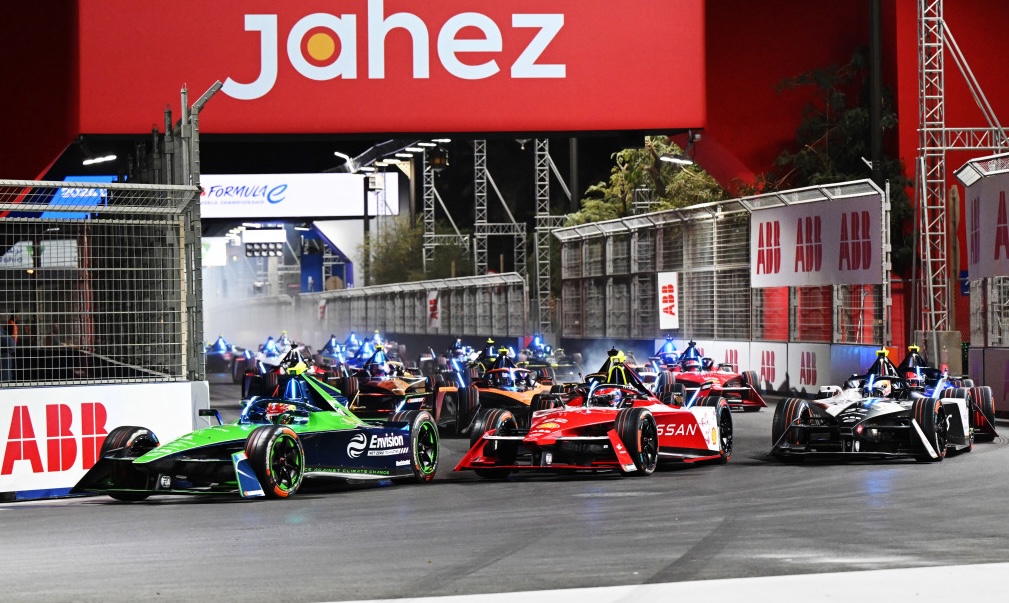Formula E CEO Jeff Dodds says the series will “retain its DNA” and “be a street racing series” going forward, despite a recent influx of permanent facilities to the all-electric series’ calendar.
Portland International Raceway joined Autodromo Hermanos Rodriguez on the schedule last year, with Misano and the Shanghai International Circuit being added this season. But while it looks like a trend that counters Formula 1’s recent influx of street circuits, Dodds says it’s not one that will explicitly continue.
“There’s a story behind every venue,” he said when it was pointed out that Formula E and F1 appeared to have swapped MOs when it came to calendar curation. “We’re a racing series born out of street racing, born out of city circuits and yes, we’ve seen Formula 1 in recent times move more towards street circuits, and I think they would say to you the reason they do that is because it promotes a different style of racing — it’s very compelling to have motor racing within a city center, it’s a different audience that you attract, all the things we’ve known since we started this series.”
Unlike F1, though, Formula E cars are getting considerably quicker with each generation, and it’s that which has persuaded the series to keep one eye on permanent facilities.
“Our cars are getting faster. We have cars that accelerate to 100 kilometers an hour in 2.6 seconds, cars that top out at over 200mph — it’s not always possible to build a street circuit in certain locations where you can race and showcase the potential of the car safely,” Dodds explained.
[lawrence-auto-related count=3 category=1394]
Of this year’s new additions, Misano came out of a desire to remain in Italy, but with Formula E’s new cars seemingly outgrowing the the most recent Rome E-Prix location, an alternative was needed — not that the Italian stop on the schedule couldn’t be a street circuit again in the future, though.
“I think we were very honest. We love the Rome race — amazing venue, amazing circuit — but [it is] right at the limit of where the car is from a power point of view,” Dodds conceded. “We saw in Rome last year two very big accidents; fortunately all drivers walked away very safely.
“But we’re looking at our options in Italy going forward, we’re open to a street circuit providing it can showcase the potential of the car and we can do it safely. We think that Misano is a brilliant fixed circuit with a load of motorsport heritage in a brilliant location to go and show a different type of racing in Italy, certainly for Season 10.”

For China, the series was keen to get back in the country as soon as possible following its re-opening after the COVID pandemic, and the F1-ready Shanghai International Circuit ticked a number of boxes in its readymade state.
“We’ve raced in China before on a street circuit — Beijing, the first-ever race in Formula E, was on a street circuit,” Dodds points out. “China’s an incredibly important market for everyone in Formula E, particularly the manufacturers.
“When I landed in this role, one of my top priorities was to get us racing again in China, and with the time frame I gave the team, an amazing option — it’s a brilliant circuit, in a great location, amazing transport links and infrastructure. They’ve got a circuit size which fits us perfectly and because it’s a fixed circuit, it’s relatively easy to do as opposed to shutting down roads and getting permissions and stuff like that, so it was perfect for us to re-introduce ourselves into China.”
The question of street circuits versus permanent tracks isn’t a straightforward one, Dodds acknowledged, but he insists street races will continue to be at Formula E’s core.
“I think there’s a different answer depending on individual locations,” he said. “What I will say is in the future, we will retain our DNA, we will be a street racing series, but there will be some races where we take the benefit of using a fixed circuit. But that fixed circuit has to be able to deliver a compelling race.
“If you look at somewhere like Portland, there were a lot of skeptics, and as we came off the race there were a lot of converts. And we actually delivered our fastest-ever on-track top speed at that race in Portland because it allowed us to showcase the potential of the car. So I think it’s finding that balance.”
